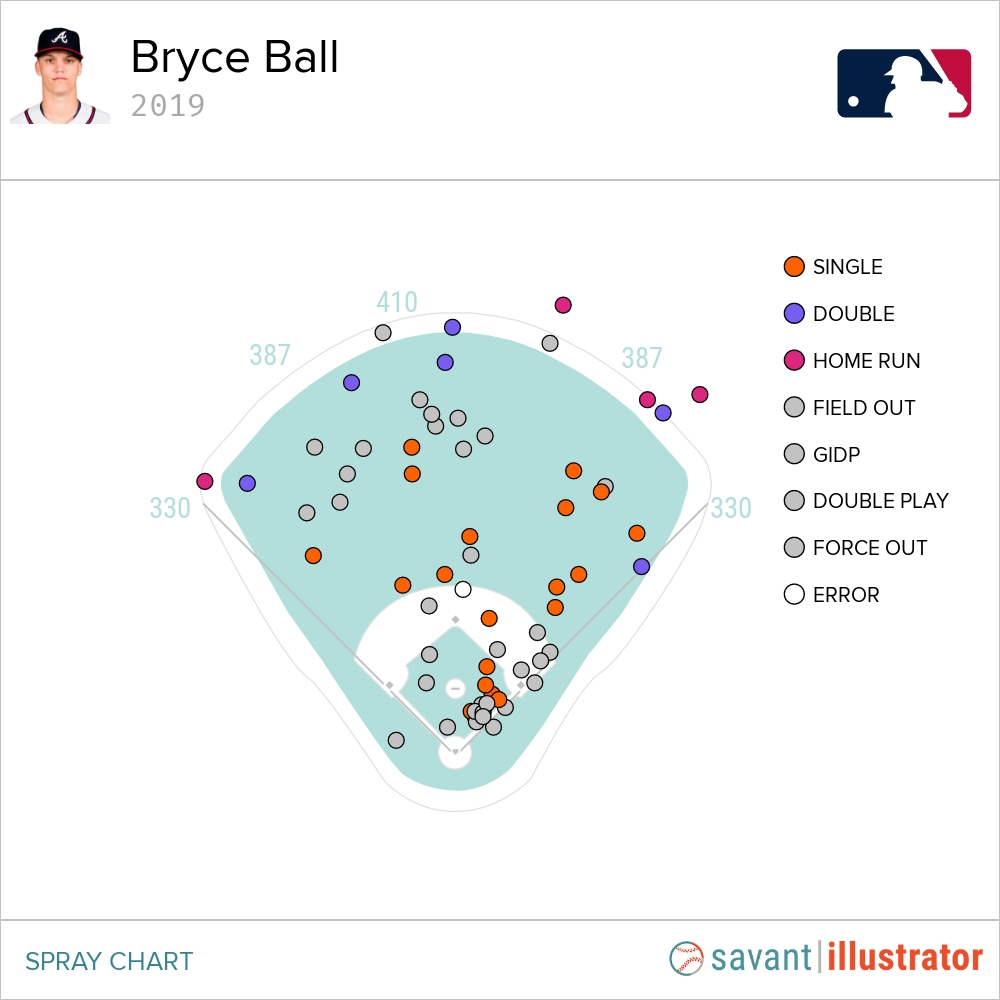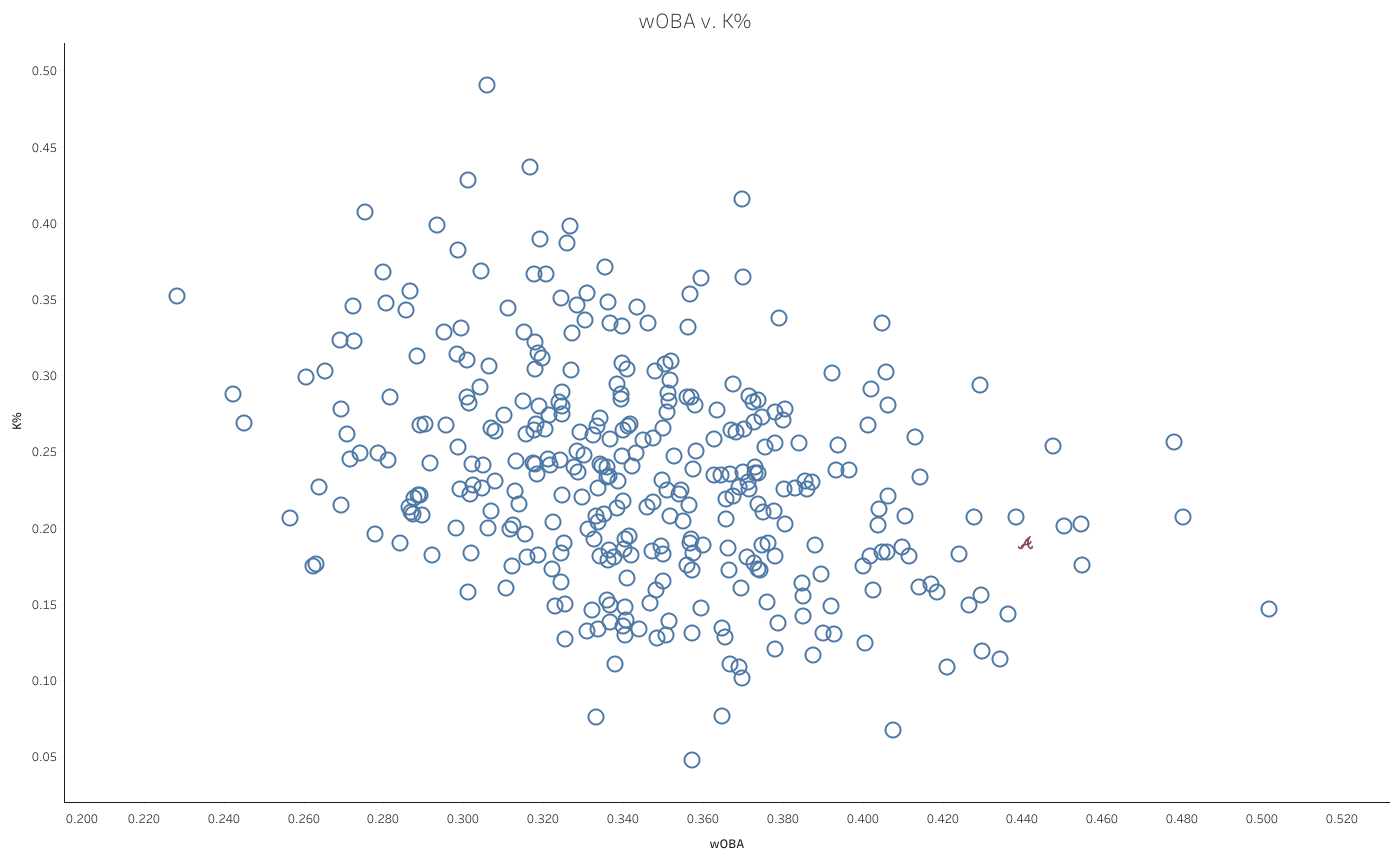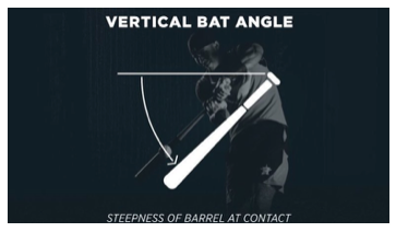Although Bryce Ball has been in pro ball one year, the Braves have seen an emerging bat that could be their future 1B/DH. In 2020, the lefty was invited to spring training as a non-roster participant and a part of the 60 man roster this season. Ball has always had a hit tool, whether he was at Newman Catholic HS (IA), NIACC (Northern Iowa Community College), or Dallas Baptist University.
Dominating at the College Level
He didn’t just have good numbers, he dominated at the college level:
Two years at NIACC:
| G | AB | R | H | 2B | 3B | HR | RBI | BB | K | SB | CS | AVG | OBP | SLG | |
|---|---|---|---|---|---|---|---|---|---|---|---|---|---|---|---|
| 2016-17 | 58 | 203 | 49 | 85 | 22 | 1 | 7 | 52 | 47 | 37 | – | – | 0.419 | 0.534 | 0.640 |
| 2017-18 | 54 | 170 | 46 | 50 | 11 | 0 | 14 | 44 | 40 | 56 | 0 | 1 | 0.294 | 0.433 | 0.606 |
| Total | 112 | 373 | 95 | 135 | 33 | 1 | 21 | 96 | 87 | 93 | 0 | 1 | 0.362 | 0.487 | 0.625 |
One Year at DBU:
| G | AB | R | H | 2B | 3B | HR | RBI | BB | K | SB | CS | AVG | OBP | SLG | |
|---|---|---|---|---|---|---|---|---|---|---|---|---|---|---|---|
| 2018-19 | 63 | 228 | 54 | 74 | 12 | 0 | 18 | 54 | 51 | 53 | 3 | 2 | 0.325 | 0.443 | 0.614 |
In 2019, Ball led the MVC, a solid mid-major conference, in HR, RBIs, and walks. Ball helped his draft stock in the 2019 Lubbock Regional going 8/14 against arms from Texas Tech and Florida, reassuring scouts could hit quality pitching.
First Year of Pro Ball Success
Ball’s success continued in the Braves organization.
| Season | Tm | LG | L | G | PA | AB | R | H | 2B | 3B | HR | RBI | BB | SO | SB | CS | HBP | AVG | OBP | SLG | OPS |
|---|---|---|---|---|---|---|---|---|---|---|---|---|---|---|---|---|---|---|---|---|---|
| 2019 | Danville Braves | APP | ROA | 41 | 173 | 145 | 37 | 47 | 12 | 0 | 13 | 38 | 22 | 30 | 0 | 0 | 2 | 0.324 | 0.41 | 0.676 | 1.086 |
| 2019 | Rome Braves | SAL | A(Full) | 21 | 90 | 86 | 14 | 29 | 6 | 0 | 4 | 14 | 4 | 20 | 0 | 0 | 0 | 0.337 | 0.367 | 0.547 | 0.913 |
| 2019 | 2 Teams | Minors | 62 | 263 | 231 | 51 | 76 | 18 | 0 | 17 | 52 | 26 | 50 | 0 | 0 | 2 | 0.329 | 0.395 | 0.628 | 1.023 |
His batted ball direction % in his first year of pro ball is what you would like to see out of a power hitter: Pull: 48.4%, Cent: 20.9%, and Oppo: 30.7%. His power does come from the pull side, but he can easily hit the ball out to center, left center, or left field.
MiLB Comparison
To put it in the perspective of how great he was during his first pro ball season, let’s look into how Bryce Ball compared to other MiLB 1B in the 2019 season. The data includes first-basemen in 2019 that competed at any MiLB level with at least 200 PA.
He ranked 8th in wOBA and was able to control his K% fairly well compared to his competition. Between Danville (Rookie Ball) and Rome (Class A) he slashed .329/.395/.628.
One stat that really impressed me with Ball in 2019 was his SwStr% of 8.4%, the max in the sample of the 347 hitters was around 43%. He proved in year one that he will be able to hit for power with a solid understanding of the strike zone and good barrel control. Ball slugged the ball roughly .200 points higher than other MILB 1B and was ranked fifth in wRC+.
Two numbers that stick out to me are his IFFB% and HR/FB, he outperformed the field in both categories. Having a solid HR/FB shows he can get the ball in the air with velocity and lower IFFB% are signs of a good bat path. Ball has the bat speed and strength to miss-hit balls out of the park, I’m sure the Braves are very excited to see what the lefty can do in a full year of pro ball.
| Name | BABIP | GB/FB | LD% | GB% | FB% | IFFB% | HR/FB | Pull% | Cent% | Oppo% | SwStr% |
|---|---|---|---|---|---|---|---|---|---|---|---|
| Bryce Ball | 0.351 | 1.00 | 23.33% | 38.33% | 38.33% | 13.04% | 0.25 | 49.19% | 19.46% | 31.35% | 8.38% |
| MILB 1B | 0.318 | 1.16 | 20.10% | 41.88% | 38.02% | 20.44% | 0.11 | 45.24% | 24.02% | 30.75% | 14.83% |
| Name | BB% | K% | BB/K | AVG | OBP | SLG | OPS | ISO | Spd | BABIP | wSB | wRC | wRAA | wOBA | wRC+ |
|---|---|---|---|---|---|---|---|---|---|---|---|---|---|---|---|
| Bryce Ball | 9.89% | 19.01% | 0.52 | 0.329 | 0.395 | 0.628 | 1.023 | 0.299 | 2.0 | 0.351 | 0.11 | 58 | 24.4 | 0.441 | 173 |
| MILB 1B | 9.97% | 23.42% | 0.47 | 0.257 | 0.340 | 0.416 | 0.756 | 0.159 | 3.9 | 0.318 | -0.12 | 48 | 4.9 | 0.345 | 110 |
A co-founder of Baseball Prospectus named Clay Davenport created an MLB equivalent projection system for most levels of pro baseball. It is defined as estimating the Major League equivalent performance statistics based on player statistics from minor league and international baseball. The translations put everyone on a level playing field, projecting how they would perform based on their current statistics. In a six-year span, starting from 2021, Ball’s translation has him around 20+ HR and .260 – .270 hitter. His 2021 season projection compared him to Prince Fielder, Matt Adams, Austin Riley, Xander Bogaerts, and more. I’m sure as Ball progresses, his projection will continue to increase if he is producing at this level.
Did His Swing Change?
I have been a fan of Bryce’s stance and load. He keeps it simple in the box and is always on time with the pitcher. He has kept his swing consistent throughout the years, there wasn’t much the Braves needed to clean up when he arrived.
The only slight difference I see is in his setup. It looks like his upper body is squarer to the pitcher with the Braves. The position of the front elbow, the wrinkle in the jersey facing the pitcher and the numbers on the back look slightly different when comparing the two setups. An improved set up could contribute to better plate vision, bat path, ball spin, etc. One characteristic of his swing that sticks out to me is his vertical bat angle which is the angle of the bat as it travels along the plane — timing along with the barrel slot (Swing Graphs). Increasing vertical bat angle allows hitters to be more consistent with his attack angle and increases zone coverage.
Vertical bat angle is something that is different for everyone depending on what kind of bat path they have, guys with a Ferris wheel/circular path (Judge, Freeman, Acuna) will have higher VBAs than players with a flatter path (Donaldson, Bogaerts, Bregman). VBA is pitch dependent as well, for example, Freddie Freeman needs to flatten out his path much more on a pitch at the top of the zone compared to hitting balls in the bottom of the zone. If a player can go get a pitch on the inside half at 43 degrees, he can get a ball on the outer third at 30 degrees. Bryce Ball stands at 6’6 meaning his strike zone is larger than the average MLB hitter, at his height having a higher VBA helps him cover his strike zone more effectively.
Are VBAs a Trend Within the Braves Organization?
This past May, @swinggraphs tweeted “Acuna had the 3rd biggest VBA increase in 2019. Dansby Swanson was 2nd – but get this – Swanson had one of the biggest decreases in spin that we’ve ever seen and Dansby Swanson also had the largest improvement in LA tightness (SDLA) in the MLB last year”.
This tweet got me thinking so I reached out to him and he had gone more in depth about this:
“VBA has a really high correlation w/ std dev LA – which correlate to other ‘contact quality’ metrics – IFFB rate, amount of backspin, BABIP, etc. So for Swanson, big change in VBA and seeing the other metrics change also. His performance is better as well (but nothing to write home about) – but could mean there’s a lot more coming if he continues to move things in a similar direction. So curious if the Acuna, Swanson is org. driven, influenced by Freddie F (who is one of highest VBA hitters), or just simply a coincidence”.
It will be interesting to see if more Braves prospects will have higher VBA numbers as they come up through the organization.
The swing on the HR from Ball in spring training has a VBA of 44° which is Freddie Freeman range in that location. There are not many low-ball hitters like Freeman, it’s a good sign to see that Bryce is already showing swing similarities of the 2020 NL MVP.
Future Outlook
It is easy to look at Bryce Ball and see a future Freddie Freeman, LHH, present/future power tool, similar bat path, and looking/acting the part of a hitter in the box. Freddie Freeman will be entering his last year of his eight-year contract (8 yr(s) / $135,000,000) in 2021. If I were the Braves it would be hard not to re-sign someone who has received MVP votes the past four out of five years (at least a five-year deal IMO). There may be a situation where Ball is MLB ready, but Freeman is still producing at an all-star level, which is the best-case scenario (hopefully with an NL DH). These two could repeat history and be the next Hank Aaron/Eddie Mathews power-hitting duo for multiple years in Atlanta. He has an advanced bat already; he just needs more at-bats against pro-level pitching. There is the ability to hit 25-30+ HR consistently and hit for average. He can hit pitches at the top and bottom of the zone which is the way pitchers are attacking a lot of hitters right now. This is someone who is great value in deeper fantasy dynasty leagues, with a DH spot in the talks for the NL having Ball would be a great addition to anyone’s roster.
I believe Ball does have the ability to hit his way to the majors, and he is athletic enough to play first base if DH isn’t an option. He moves well (used to play OF in JUCO) and with the help of Infield Coach Ron Washington, there is a good chance he can develop into an everyday first baseman. My prediction is Ball will get his first big league at-bat in 2022 and if MLB rules a full-time DH in the National League then it will make it hard for the Braves to keep him down if he keeps producing at this level. Braves fans should be excited about this prospect, it will be exciting to see how he develops through the organization.
Feature Article Image by Justin Redler (@reldernitsuj on Twitter




